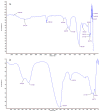Targeting Cell Adhesion Molecules via Carbonate Apatite-Mediated Delivery of Specific siRNAs to Breast Cancer Cells In Vitro and In Vivo
- PMID: 31269666
- PMCID: PMC6680929
- DOI: 10.3390/pharmaceutics11070309
Targeting Cell Adhesion Molecules via Carbonate Apatite-Mediated Delivery of Specific siRNAs to Breast Cancer Cells In Vitro and In Vivo
Abstract
While several treatment strategies are applied to cure breast cancer, it still remains one of the leading causes of female deaths worldwide. Since chemotherapeutic drugs have severe side effects and are responsible for development of drug resistance in cancer cells, gene therapy is now considered as one of the promising options to address the current treatment limitations. Identification of the over-expressed genes accounting for constitutive activation of certain pathways, and their subsequent knockdown with specific small interfering RNAs (siRNAs), could be a powerful tool in inhibiting proliferation and survival of cancer cells. In this study, we delivered siRNAs against mRNA transcripts of over-regulated cell adhesion molecules such as catenin alpha 1 (CTNNA1), catenin beta 1 (CTNNB1), talin-1 (TLN1), vinculin (VCL), paxillin (PXN), and actinin-1 (ACTN1) in human (MCF-7 and MDA-MB-231) and murine (4T1) cell lines as well as in the murine female Balb/c mice model. In order to overcome the barriers of cell permeability and nuclease-mediated degradation, the pH-sensitive carbonate apatite (CA) nanocarrier was used as a delivery vehicle. While targeting CTNNA1, CTNNB1, TLN1, VCL, PXN, and ACTN1 resulted in a reduction of cell viability in MCF-7 and MDA-MB-231 cells, delivery of all these siRNAs via carbonate apatite (CA) nanoparticles successfully reduced the cell viability in 4T1 cells. In 4T1 cells, delivery of CTNNA1, CTNNB1, TLN1, VCL, PXN, and ACTN1 siRNAs with CA caused significant reduction in phosphorylated and total AKT levels. Furthermore, reduced band intensity was observed for phosphorylated and total MAPK upon transfection of 4T1 cells with CTNNA1, CTNNB1, and VCL siRNAs. Intravenous delivery of CTNNA1 siRNA with CA nanoparticles significantly reduced tumor volume in the initial phase of the study, while siRNAs targeting CTNNB1, TLN1, VCL, PXN, and ACTN1 genes significantly decreased the tumor burden at all time points. The tumor weights at the end of the treatments were also notably smaller compared to CA. This successfully demonstrates that targeting these dysregulated genes via RNAi and by using a suitable delivery vehicle such as CA could serve as a promising therapeutic treatment modality for breast cancers.
Keywords: breast cancer; carbonate apatite; gene silencing; nanoparticle; paxillin and actinin-1; siRNA; talin-1; vinculin; α-catenin; β-catenin.
Conflict of interest statement
The authors declare no conflicts of interest.
Figures























Similar articles
-
siRNAs Targeting Growth Factor Receptor and Anti-Apoptotic Genes Synergistically Kill Breast Cancer Cells through Inhibition of MAPK and PI-3 Kinase Pathways.Biomedicines. 2018 Jun 22;6(3):73. doi: 10.3390/biomedicines6030073. Biomedicines. 2018. PMID: 29932151 Free PMC article.
-
Carbonate Apatite Nanoparticles-Facilitated Intracellular Delivery of siRNA(s) Targeting Calcium Ion Channels Efficiently Kills Breast Cancer Cells.Toxics. 2018 Jun 26;6(3):34. doi: 10.3390/toxics6030034. Toxics. 2018. PMID: 29949888 Free PMC article.
-
Delivery of siRNAs Against Selective Ion Channels and Transporter Genes Using Hyaluronic Acid-coupled Carbonate Apatite Nanoparticles Synergistically Inhibits Growth and Survival of Breast Cancer Cells.Int J Nanomedicine. 2024 Jul 29;19:7709-7727. doi: 10.2147/IJN.S440419. eCollection 2024. Int J Nanomedicine. 2024. PMID: 39099788 Free PMC article.
-
Polyethylenimines for RNAi-mediated gene targeting in vivo and siRNA delivery to the lung.Eur J Pharm Biopharm. 2011 Apr;77(3):438-49. doi: 10.1016/j.ejpb.2010.11.007. Epub 2010 Nov 18. Eur J Pharm Biopharm. 2011. PMID: 21093588 Review.
-
Gene silencing through RNA interference (RNAi) in vivo: strategies based on the direct application of siRNAs.J Biotechnol. 2006 Jun 25;124(1):12-25. doi: 10.1016/j.jbiotec.2005.12.003. Epub 2006 Jan 18. J Biotechnol. 2006. PMID: 16413079 Review.
Cited by
-
STK11 mutation affects tumor proliferation by impacting CD4+ T cell activity in lung adenocarcinoma.Cent Eur J Immunol. 2024;49(3):320-330. doi: 10.5114/ceji.2024.143578. Epub 2024 Oct 28. Cent Eur J Immunol. 2024. PMID: 39720276 Free PMC article.
-
Inhibition of the lncRNA Coded within Transglutaminase 2 Gene Impacts Several Relevant Networks in MCF-7 Breast Cancer Cells.Noncoding RNA. 2021 Aug 18;7(3):49. doi: 10.3390/ncrna7030049. Noncoding RNA. 2021. PMID: 34449674 Free PMC article.
-
Multivariate Cox regression analysis of prognostic genes and therapeutic mechanisms of gastric cancer.Discov Oncol. 2025 Feb 8;16(1):136. doi: 10.1007/s12672-025-01907-7. Discov Oncol. 2025. PMID: 39921793 Free PMC article.
-
Carbonate Apatite and Hydroxyapatite Formulated with Minimal Ingredients to Deliver SiRNA into Breast Cancer Cells In Vitro and In Vivo.J Funct Biomater. 2020 Sep 10;11(3):63. doi: 10.3390/jfb11030063. J Funct Biomater. 2020. PMID: 32927738 Free PMC article.
-
Role of the V1G1 subunit of V-ATPase in breast cancer cell migration.Sci Rep. 2021 Feb 25;11(1):4615. doi: 10.1038/s41598-021-84222-9. Sci Rep. 2021. PMID: 33633298 Free PMC article.
References
LinkOut - more resources
Full Text Sources
Miscellaneous

